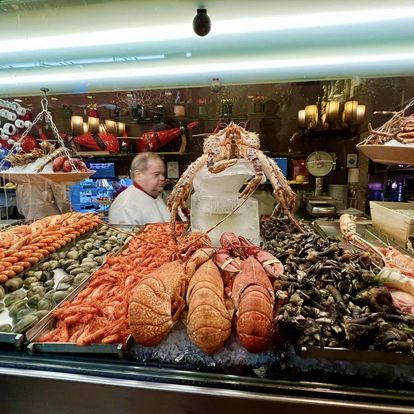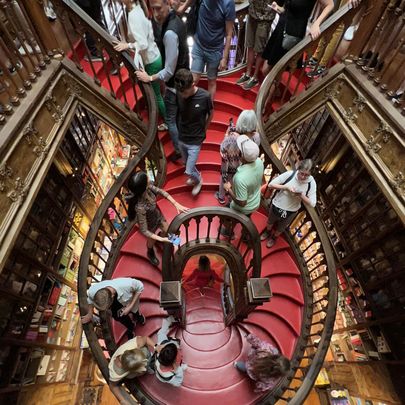
Above photo: Porto from Edifíco Miraduoro, the highest point in the city. Photo credit: Stephanie Chambers
#padding-48 { height:40px; }#text-block-49 { margin-bottom:0px; text-align:left; }
Invicta, Invincible Porto, was never conquered and is considered the city of poets.
#padding-50 { height:40px; }
#text-block-53 { margin-bottom:0px; text-align:center; }
Completed in 1739, San Ildefonso near Batalha Square, was built in a Baroque style. The azulejo tiles were added in 1932.
#padding-54 { height:40px; }
#text-block-56 { margin-bottom:0px; text-align:center; }
Our room at the Palace de Torel in Porto was dedicated to the poet, Antero de Quental. Steve Chambers with painting of de Quental. “…dreams aren’t always in vain.”
#padding-57 { height:40px; }
#text-block-59 { margin-bottom:0px; text-align:center; }
Though the national dish of Portugal is dried and salted cod, a wide array of fresh seafood is abundant in its markets and restaurants.
#padding-60 { height:40px; }
#text-block-62 { margin-bottom:0px; text-align:center; }
With its dazzling staircases that wind back on themselves, stained glass windows, and ornamental ceilings, Lello is considered the most beautiful bookstore in the world.
#padding-63 { height:40px; }
#text-block-65 { margin-bottom:0px; text-align:center; }
Fado music performance in the Moorish Quarter of Porto
. { }
It took us four days to wrap our heads around one of the most literary, creative, and intellectual cultures we’ve ever visited. In Portugal, though you sightsee and consume, you must engage in a dialogue with its people to capture its character. After landing at the Porto airport, we checked into the Palace de Torel, a home built by a family in the 19th century. Restored a few years ago, it had its inaugural opening in 2020, and honors the iconic poets and writers of Portugal. From flying books on the library ceiling (see gallery below) to each room with a writer’s painting and quotations along the way, it was our initial introduction to the ingenuity of this city. Our room was dedicated to Antero de Quental.
#text-block-68 { margin-bottom:0px; text-align:left; }
AZULEJO TILEWORK
The tiles and porcelain of Portugal, most notably on the facade of architecture in Porto, are one of its most distinctive and charming features. Azulejos (blue tiles) first came to Portugal from Spain in the 15th Century when the Iberian Peninsula was still under Moorish rule. The Portuguese quickly realized that the porcelain enlivened and lightened the drab granite facades of their structures. They’ve used it in a traditional way as decorative art and as a means for artists and architects to honor the graffiti artists (one architect used his graffiti sketches on the columns in his Pritzker-winning Metro station) and satirize the missteps in their colorful geo-political history.
#text-block-69 { margin-bottom:0px; text-align:left; }
FOOD IN PORTUGAL
Our exceptional guides to Portuguese food, history, and architecture were provided by a company called Taste Portugal, arranged by Delectable Destinations . The integration of these three elements provided a unique twist on the usual culinary experience and an entrée to the culture like no other. Cooking classes were by conducted by the chef for Cook in Ribeira. Portuguese dishes include meats: pork, beef, poultry, and game; seafood: fish, crustaceans such as lobster, crab, shrimps, prawns, octopus, and mollusks such as scallops, clams and barnacles (yes, we ate barnacles!); vegetables and legumes; desserts, nut cakes being the most common. Rice is a very important staple—the risotto-like dish is more of a stew with fish, peppers, and tomatoes. While cod can be the main star of dishes that are baked, grilled and fried into fritters, it’s is an ingredient and flavoring for others. Many fruits and vegetables are sourced from The Azores. Most vegetables are prepared as a puréed broth or broth for meats and fish.
The national dish of Portugal, bacalhau, is dried and salted codfish, which is usually soaked in milk or water before cooking. The Portuguese have been eating bacalhau since the 16th century when their fishing boats brought it back from Newfoundland.
#text-block-70 { margin-bottom:0px; text-align:left; }
WORLD’S MOST BEAUTIFUL BOOKSTORE
The most interesting bookstore in the world is Lello in Porto Portugal. It began as a publishing company and still has an imprint of classic books today. Portuguese authors and poets are the most revered artists in this country, where it’s language expresses itself best in poetry. The rectangular plan covers two-stories, representing a simple mass, covered in tiled roof. The building’s exterior has mixed architectural styles suggesting Neo-Gothic, and Art Nouveau elements, and in the interior, implied Art Deco elements. The first floor includes a gothic arch, divided into three parts, with the central arch providing entrance into the building and decorative lateral windows, each adapted to the archway. Above this arch are three elongated rectangular windows flanked by two painted figures representing “Art” and “Science.”
Finishing the facade are squared plaits surmounted by three decorated pinnacles, with two pilasters on either side, topped by pinnacles of equal design. Decorative elements complete the facade with alternating geometric shapes that circuit and the firm’s name LELLO & BROTHER. We spent most of our time there trying to figure out how the staircase works. Advanced reservations to get in are suggested—amount of people allowed in at one time is restricted. Your choice from a selection of books comes with the ticket. We selected their printing of Tom Sawyer and a Portuguese Nobel Poet Laureate.
FADO MUSIC
Across the world, fado is a musical symbol of Portuguese culture and tradition. This melancholic genre, which translates to “fate” in Latin, reveals the passion in the Portuguese disposition, and evokes a despairing belief in a futile destiny filled with pining and hopelessness. In particular, fado is a melancholy story set to a haunting melody, and therein lays its sad beauty. We must accept our fate, even if it’s cruel, especially if it’s cruel. The genre took root nearly two centuries ago in hardscrabble, working-class neighborhoods of Lisbon. Although the origins are difficult to trace, today fado follows a certain traditional structure about the sea or the life of the poor, and infused with a sentiment of resignation, fate and melancholy. It is loosely captured by the Portuguese word saudade, or longing, symbolizing a feeling of permanent, irreparable loss and its consequent lifelong damage. Fado appeared during the early 19th century in Lisbon, and is believed to have its origins in the port districts such as Alfama, Mouraria and Bairro Alto. There are numerous theories about the origin of fado. Some trace it to the Medieval “cantigas de amigo” (song of a friend), some ancient Moorish influence and the chants of Africans sailing at sea, but none is conclusive. It possibly evolved and formed, from a mixture of several older musical genres. Fado performances today may be accompanied by a string quartet or a full orchestra. The “fado houses” in Lisbon are in the Arabic Quarter and meals are cooked and served in the often tiny homes by the family of the fado performers.
#padding-72 { height:40px; }
#gallery-loop-73 { margin-bottom:20px; margin-top:8px; } #gallery-loop-73 .item-holder{ margin:0 4px 8px; } #gallery-loop-73 .image-hover-overlay { } #gallery-loop-73 .hover-grayscale .image-hover-overlay img { filter:url(‘http://chambersarchitects.com/wp-content/themes/jupiter/assets/images/grayscale.svg#greyscale’); }
#padding-74 { height:40px; }
The post Porto: Portal to Poets appeared first on Stephen B. Chambers Architects, Inc..







